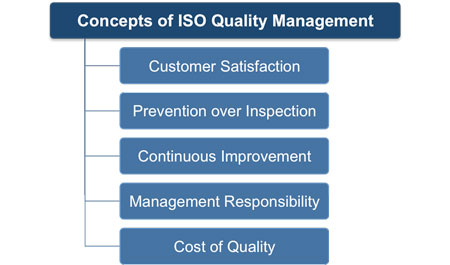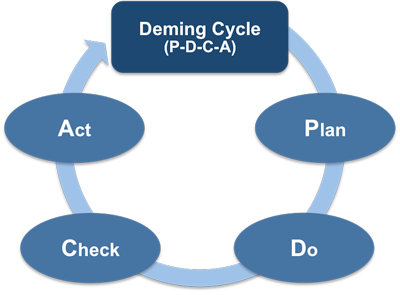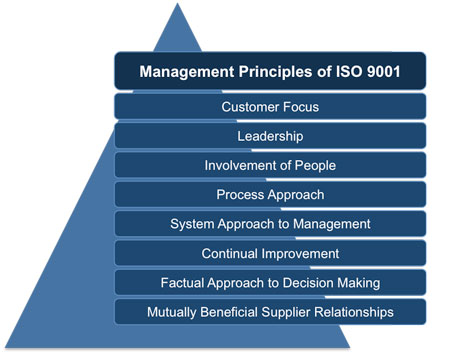Project Management and ISO Quality Management
The ISO approach to quality management emphasizes the following concepts:
 |
Customer Satisfaction
Quality means delivering the product so that its requirements meet the customer's expectations. However, this does not mean gold plating, or adding requirements that the customer did not request.
Prevention over Inspection
Inspection can reduce the probability of defects, but prevention through planning, designing, and building in quality can reduce that probability of defects for a lot less cost than through the inspection process.
Continuous Improvement
The Plan-Do-Check-Act cycle, which is the basis of the concept of continuous improvement, is derived from a business process model developed by Walter A. Shewhart and popularized by W. Edward Deming. This iterative four-step management method is used for the control and continuous improvement of processes and products.
 |
Total Quality Management, Six Sigma, Lean Six Sigma, and the Japanese Toyota Way are modern quality improvement initiatives that improve the quality of project management while improving the quality of the final deliverables. The steps in each successive PDCA cycle are:
Plan - Understand the existing situation and then establish the objectives and processes necessary to deliver results in accordance with the target or goals.
Do - Implement the plan. That is, execute the planned process.
Check - Study the actual results of the previous phase and compare them against the expected targets or goals to discover any differences. Look for deviation from the plan in implementation and also look for the appropriateness and completeness of the plan to enable the execution. Convert the collected data into a form that can be used in the next step.
Act - Where there are significant differences between actual and planned results request corrective actions. Analyze the differences to determine their root causes. Determine where to apply changes that will include improvement of the process or product.
Management Responsibility
Rather than thinking that quality is what job operators do on the factory floor, the modern concept of quality improvement initiatives mentioned in the last paragraph require the approval and active participation of management.
Cost of Quality
This is the cost of implementing quality standards. For example, if the defect is caught before the product gets shipped to the customer, this is an internal cost of nonconformance, and involves scrapping the part or reworking it so that it is in conformance with the quality standards.
However, if the inspection process does not catch the defect, and it goes out to the customer, then the costs could be in terms of the claims the customer makes for replacement or repair under warranty. The cost could potentially involve legal liability, if the customer or a third party is injured.
 |
The International Standard for Quality management (ISO 9001) adopts a number of management principles that can be used to guide organizations towards improved quality.
The principles include:
Customer focus - Since the organizations depend on their customers, they should understand future needs as well as current ones. They also need to meet customer requirements and try to exceed their expectations where possible.
An organization attains customer focus when all people in the organization know what customer requirements must be met to ensure that both the internal and external customers are satisfied.
Leadership - Leaders of an organization establish unity of purpose and direction of it. They should go for creation and maintenance of such an internal environment, in which people can become fully involved in achieving the organization's quality objective.
Process approach - The desired result can be achieved when activities and related resources are managed as processes.
System approach to management - Identifying, understanding and managing all interrelated processes as a system that contributes to an organization's effectiveness and efficiency in achieving its quality objectives. Quality control involves checking transformed and transforming resources in all stages of production process.
Continual improvement - One of the permanent quality objectives of an organization should be the continual improvement of its overall performance.
Factual approach to decision making - Effective decisions are always based on the data analysis and information.
Mutually beneficial supplier relationships - Since an organization and its suppliers are interdependent, a mutually beneficial relationship between them increases the ability of both parties to add value.
You may also be interested in:
Managing Project Quality | Quality Management Techniques | Project Quality Management and ISO Quality Management | Quality Assurance | Quality Control | Testing Project Deliverables | Quality Audits | Post-Implementation Audits.
|
|


